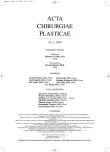-
Články
- Časopisy
- Kurzy
- Témy
- Kongresy
- Videa
- Podcasty
THE 25TH ANNIVERSARY OF BRNO BURN CENTRE: WHAT HAS CHANGED AND WHAT HAS NOT
Vyšlo v časopise: ACTA CHIRURGIAE PLASTICAE, 50, 1, 2008, pp. 3
Kategorie: Editorial
The 13th annual meeting of Czech Burn Society took place in Zastávka u Brna on October 18–19, 2007. It was organized by the Department of Burns and Reconstructive Surgery, University Hospital in Brno on the 25th anniversary of its foundation.
While reprinting some of the presentations from this conference, it is perhaps worth to consider what has changed for our patients and for us over the last quarter century Đ and what remained unchanged.
The Department of Burns and Reconstructive Surgery, University Hospital in Brno, is an integral part of the Czech Medical Care System and also a part of Czech Burn Medicine.
Its foundation was planned after World War II, together with the facilities in Prague, Ostrava, Bratislava and Košice. The final decision was made after two explosions in a Brno heating plant causing more than twenty burn casualties.
In 1982 the Burn Centre was incorporated into the Trauma Surgery Hospital on Pon‡vka Street, and in November 1989 it moved to the new University Hospital in Bohunice. In 1990 the children’s department was opened, and in 1995 the department of reconstructive surgery was added to accommodate patients needing this type of treatment.
As a result of satisfying research and teaching activities, the Centre of Burns and Reconstructive Surgery was promoted to a Department of the Medical Faculty, Masaryk University in Brno, in 2001.
Apart from the status, the prognosis of our patients has changed positively at the meantime. Patients with about 40% of total body surface area burns had a 50% chance to survive then, compared with about 70% now. Severe inhalation injury had almost 100% mortality then, while the patients involved have good chances now. Metabolic changes are much better understood and corrected now than 25 years ago. The techniques of skin replacement and of rehabilitation are more sophisticated, increasing the quality of life after severe burn injury substantially.
What has not changed much is the good position of Czech burn medicine in Europe and in the world, with very frequent contacts with the leading institutions and personalities, as well. Fortunately.
What also has not changed dramatically are the results of our struggle with burn infection, where the success is not permanent and our vigilance must be high all the time.
And finally, our permanent financial limitations and lack of long-term clear perspective has not changed in contrast with increased administrative burden many of us face. Unfortunately.
Considering that not everything is ideal, the development of those 25 years has still been positive. In fact, very positive with respect to personal freedom, the opportunity to travel, the availability of scientific information, etc.
Hopefully this trend will continue in the next decades after the transformation of the Czech Medical Care System.
Prof. Pavel Brychta, M.D., CSc.
Head of Department of Burns and Reconstructive Surgery
University Hospital Brno
Czech Republic
E-mail: pbrychta@fnbrno.cz
Štítky
Chirurgia plastická Ortopédia Popáleninová medicína Traumatológia
Článek ČESKÉ A SLOVENSKÉ SOUHRNYČlánek HOW EAST DISCOVERED WEST
Článok vyšiel v časopiseActa chirurgiae plasticae
Najčítanejšie tento týždeň
2008 Číslo 1- Metamizol jako analgetikum první volby: kdy, pro koho, jak a proč?
- Kombinace metamizol/paracetamol v léčbě pooperační bolesti u zákroků v rámci jednodenní chirurgie
- Fixní kombinace paracetamol/kodein nabízí synergické analgetické účinky
- Kombinace paracetamolu s kodeinem je účinná a bezpečná v léčbě bolesti různého původu
- Antidepresivní efekt kombinovaného analgetika tramadolu s paracetamolem
-
Všetky články tohto čísla
- MutilATing electrotrauma – case REPORT
- Award of the G. Whitaker International Burns Prize for 2007
- Specific aspects of the treatment of patients with multiple mechanical and burn injuries
- Catheter-Related Infections in Burn Patients at the Burn Centre of the University Hospital in Ostrava
- G. WHITAKER INTERNATIONAL BURNS PRIZE – PALERMO (Italy)
- Acinetobacter – serious danger FOR burn patients
- THE 25TH ANNIVERSARY OF BRNO BURN CENTRE: WHAT HAS CHANGED AND WHAT HAS NOT
- THE EFFECT OF NIFEDIPINE ON THE PATENCY OF MICROVASCULAR ANASTOMOSIS IN RATS
- Report of the 12th Congress of European Burns Association (EBA), Budapest, Hungary, September 12–15, 2007
- ČESKÉ A SLOVENSKÉ SOUHRNY
- HOW EAST DISCOVERED WEST
- Acta chirurgiae plasticae
- Archív čísel
- Aktuálne číslo
- Informácie o časopise
Najčítanejšie v tomto čísle- Specific aspects of the treatment of patients with multiple mechanical and burn injuries
- Acinetobacter – serious danger FOR burn patients
- THE EFFECT OF NIFEDIPINE ON THE PATENCY OF MICROVASCULAR ANASTOMOSIS IN RATS
- MutilATing electrotrauma – case REPORT
Prihlásenie#ADS_BOTTOM_SCRIPTS#Zabudnuté hesloZadajte e-mailovú adresu, s ktorou ste vytvárali účet. Budú Vám na ňu zasielané informácie k nastaveniu nového hesla.
- Časopisy



